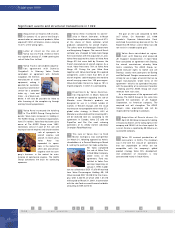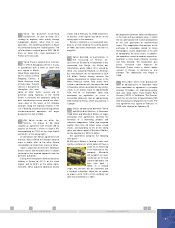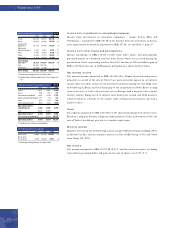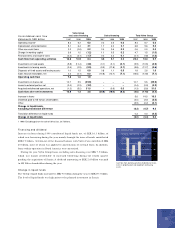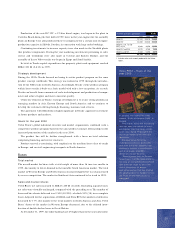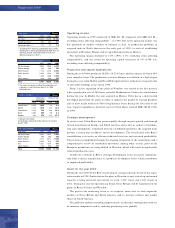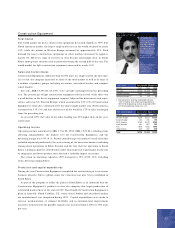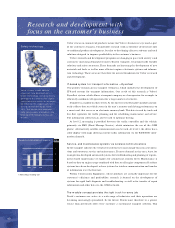Volvo 1999 Annual Report Download - page 33
Download and view the complete annual report
Please find page 33 of the 1999 Volvo annual report below. You can navigate through the pages in the report by either clicking on the pages listed below, or by using the keyword search tool below to find specific information within the annual report.
31
Production of the new DC12C, a 12-liter diesel engine, was begun in the plant in
Curitiba, Brazil during the first half of 1999. Later in the year, engines for the assembly
plants in Europe were also produced there to compensate for a certain lack of engine-
production capacity in Skövde, Sweden, in connection with large order bookings.
Continuing investments to increase capacity were also made in the Swedish plants
that produce components. During the year marketing investments pertaining to sales,
service and workshops were also made in Central and Eastern Europe, and the
assembly of heavy Volvo trucks was begun in Egypt and Saudi Arabia.
In total, in Trucks capital expenditures for property, plants and equipment reached
SEK 2,523 M (2,612) in 1999.
Strategic developm ent
During the 1990s, Trucks focused on basing its entire product program on the same
product concept worldwide. This strategy was realized in 1999 through the introduc-
tion of the NH trucks in South America. Accordingly, Trucks’ entire product program
within heavy trucks is built on a basic model with only a few exceptions. As a result,
Trucks can benefit from economies of scale in development and production of compo-
nents and achieve higher and more consistent quality.
Other key elements in Trucks’ strategic development is to secure strong positions in
emerging markets in Asia, Eastern Europe and South America and to continue to
develop the customer offering through financing, insurance and services.
The agreement with Mitsubishi is highly significant in Trucks’ aggressive investment
in future products and markets.
Goals for the year 2000
Volvo Truck’s global industrial structure and market organization, combined with a
competitive product program based on the same product concept, offers prospects for
increased penetration of the market in the year 2000.
The product line will be further strengthened, with a focus on total solutions
comprising financing and service contracts.
Product renewal is continuing, with emphasis on the medium-heavy class of trucks
in Europe, and on civil engineering transports in North America.
Buses
Total m arket
The overall market for buses with a total weight of more than 16 tons was smaller in
1999, due mainly to lower demand in the unstable South American market. The total
market in Western Europe and North America increased slightly but was characterized
by severe competition. The market in Southeast Asia continued to be weak in 1999.
Sales and m arket shares
Volvo Buses’ net sales increased to SEK 15,160 M (14,286). Excluding acquired units,
net sales were virtually unchanged, compared with the preceding year. The number of
buses and bus chassis delivered was 9,500 (10,200), of which 51% (38) were complete
buses. Adjusted for the acquisitions of MASA and Nova BUS, the number of deliveries
decreased by 17%, due mainly to the weak markets in South America and Asia. Volvo
Buses’ shares of the market in Western Europe decreased, due to the delayed intro-
duction of double-decker buses in Great Britain.
At December 31, 1999, the order backlog was 12% higher than on the year-earlier date.
Num ber of truck s produced
1997 1998 1999
Volvo FH 23,180 30,610 25,880
Volvo VN122,490 30,540 35,440
Volvo FL7, 10, 12 and
FM7, 10, 12 8,940 9,350 13,090
Volvo FLC and FL6 8,670 8,780 7,040
Volvo NL and NH 6,440 5,490 3,210
Total 69,720 84,770 84,660
1 Includes other truck models produced in the United
States.
Volvo FH12 – Truck of the
year 2000
In January, the Volvo FH12 was
nam ed “ Truck of the year 2000” in
Europe.
That m akes Volvo the first brand
that has won the industry’s most
prestigious title five tim es. At the
sam e tim e, Volvo FH became the
first truck model to win the title
two tim es.
The new Volvo FH12 has
undergone extensive alterations
with new driveline, a totally new
electronic system , a new chassis
with disc brakes and EBS
(Electronic Brake System).
“ Several press tests in Europe
have shown that the Volvo FH12 is
not only an extraordinarily com fort-
able and safe truck to drive, but
that it also offers its owner
operating savings that are am ong
the absolute best in Europe,” writes
the Truck of the Year jury in its
statement.
Trucks



